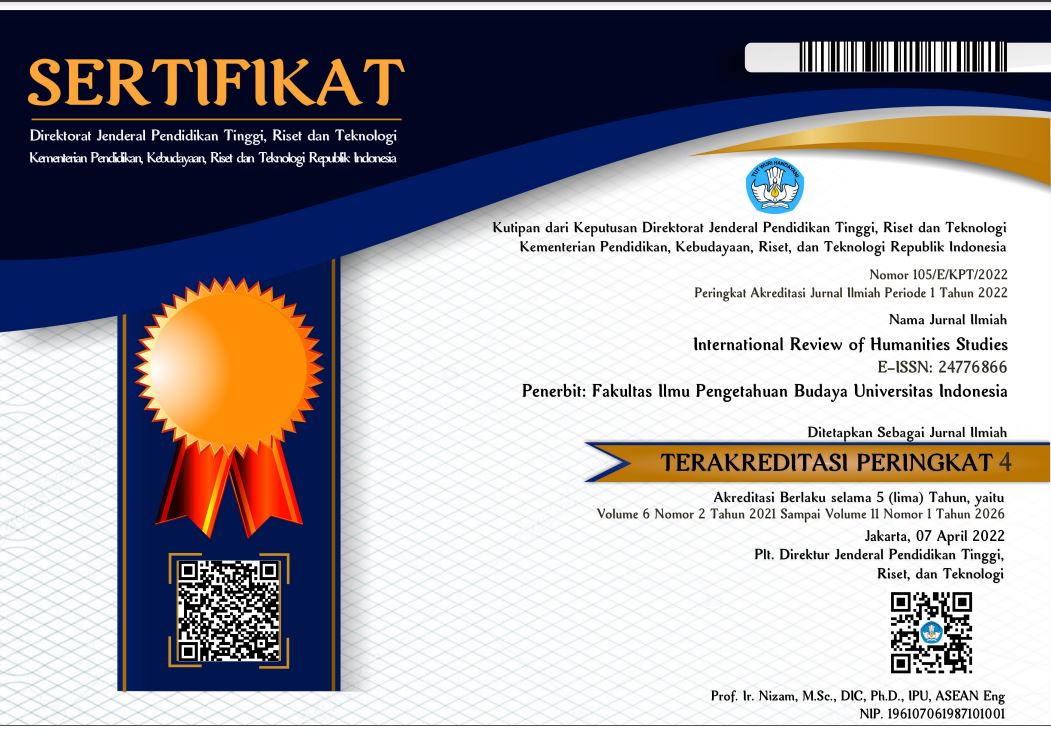International Review of Humanities Studies

Abstract
A backchannel is generally known as a response in a conversation that serves as a sign that the interlocutor is paying attention. In conversation, verbal backchannel speech can simultaneously occur with nonverbal gestures. Backchannel in conversations in digital content is often found. Beauty content from Hiro Beauty Channel shows that backchannel in beauty vlogs often occurs through verbal and nonverbal . Previous studies have researched the behaviour of backchannel usage (Cutrone, 2011; Nurjaleka, 2019; Bodur et al., 2022; Ramadhani, 2023) and the behaviour of gazing gestures (Walker, 2010). However, there has yet to be research about the multimodality of backchannels in conversations on digital content such as beauty vlogs. This research explains the pattern of backchannel usage in beauty vlogs, both from verbal and non-verbal modes. This study methodology uses conversational analysis (Sacks et al., 1974; Heritage, 2001) and multimodality (Mondada, 2018). This study's result is that the interlocutor's backchannel means that 'the interlocutor is listening' and 'the interlocutor asks the speaker to continue his speech'. Both imply that the interlocutor is paying attention to the speaker. The backchannel multimodality pattern in beauty vlogs consists of three main types, namely (i) verbal backchannel, (ii) verbal and nonverbal backchannel, and (iii) nonverbal backchannel. This study also shows that the preferred mode in providing backchannel in Japanese combines both verbal and nonverbal modes.
References
Bodur, K., Nikolaus, M., Prévot, L., & Fourtassi, A. (2022). Backchannel Behavior in Child-Caregiver Video Calls.
https://doi.org/10.31234/osf.io/cvnqm
Cutrone, P. (2011). Politeness and Face Theory: Implications for the Backchannel Style of Japanese L1/L2 Speakers. Language Studies Working Papers, 3, 51- 57. https://www.reading.ac.uk/web/files/english-languageandliterature/ell_language_6_Cutrone_vol_3. pdf
Heritage, J. (2001). Conversation analysis: Sociological. International Encyclopedia of the Social & Behavioral Sciences, 2741–2744.
https://doi.org/10.1016/b0-08-043076-7/02001-5
Hiro Beauty Channel (2023, Januari 7). [Towa hozon-ban]-hatsu no suppin meiku douga!? Tanaka Minami-chan ni oudou Tsuya hada jun yoku meiku o shi chatta wa yo 〜 🤍
[Video]. YouTube. https://www.youtube.com/watch?v=UwC6vi8SjGQ&t=76s
Iwasaki, S. (1997). The Northridge earthquake conversations: The Floor Structure and the ‘loop’ sequence in Japanese conversation. Journal of Pragmatics, 28(6), 661– 183 693.
https://doi.org/10.1016/s0378-2166(97)00070-2
Kita, S., & Ide, S. (2007). Nodding, Aizuchi, and final particles in Japanese conversation: How conversation reflects the ideology of communication and social relationships. Journal of Pragmatics, 39(7), 1242–1254.
https://doi.org/10.1016/j.pragma.2007.02.009
Maynard, S. K. (1986). On back-channel behavior in Japanese and english casual conversation. Linguistics, 24(6). h
ttps://doi.org/10.1515/ling.1986.24.6.1079
Mondada, L. (2018). The multimodal Interactional Organization of tasting: Practices of tasting cheese in Gourmet Shops. Discourse Studies, 20(6), 743–769.
https://doi.org/10.1177/1461445618793439
Nurjaleka, L. (2019). Backchannel Behavior in interview discourse: A Contrastive Study between Japanese and Indonesian. Proceedings of the Eleventh Conference on Applied Linguistics (CONAPLIN 2018).
https://doi.org/10.2991/conaplin-18.2019.300
Ramadhani, B. M., Yudistira, A., & Anaya, I. (2023). Studi Perbandingan Penggunaan Aizuchi Dalam Bahasa Indonesia dan bahasa jepang : Percakapan Pada situasi Pertemuan Pertama. JURNAL Al-AZHAR INDONESIA SERI HUMANIORA, 8(1), 45.
https://doi.org/10.36722/sh.v8i1.1771
Sacks, H., Schegloff, E. A., & Jefferson, G. (1974). A simplest systematics for the organization of turn-taking for conversation. Language, 50(4), 696.
https://doi.org/10.2307/412243
Schegloff, E. A. (1982). Discourse as An Interactional Achievement some Uses of 'Uh Huh’ and other Things that Come Between Sentences. In D. Tannen (Ed.), Analyzing discourse: Text and talk (pp. 71–93). essay, Georgetown University Press.
Schegloff, E. A. (2007). Sequence Organization in interaction: A Primer in conversation analysis I. Cambridge University Press.
Taslaud, G. INSG.CO. (2023, Februari 28). Influencer marketing in Japan in 2023 - data and Insights. INSG.CO.
https://www.insg.co/en/influencer-marketing-japan/
Walker, N. L. (2010). Recipient response behaviour during Japanese storytelling: A combined quantitative/multimodal approach (Master Thesis). University of Alberta, Edmonton, Alta.
Recommended Citation
Filia, Filia Dr. and Muthia, Nilam Husna
(2024)
"MULTIMODALITY OF JAPANESE BACKCHANNEL IN BEAUTY VLOG,"
International Review of Humanities Studies: Vol. 9:
No.
1, Article 13.
DOI: 10.7454/irhs.v9i1.1280
Available at:
https://scholarhub.ui.ac.id/irhs/vol9/iss1/13
Included in
Anthropology Commons, Art and Design Commons, Creative Writing Commons, Cultural Heritage Law Commons, Education Law Commons, Film and Media Studies Commons, History Commons, Intellectual Property Law Commons, International and Area Studies Commons, Legal Writing and Research Commons, Linguistics Commons, Museum Studies Commons, Philosophy Commons, Urban Studies and Planning Commons



